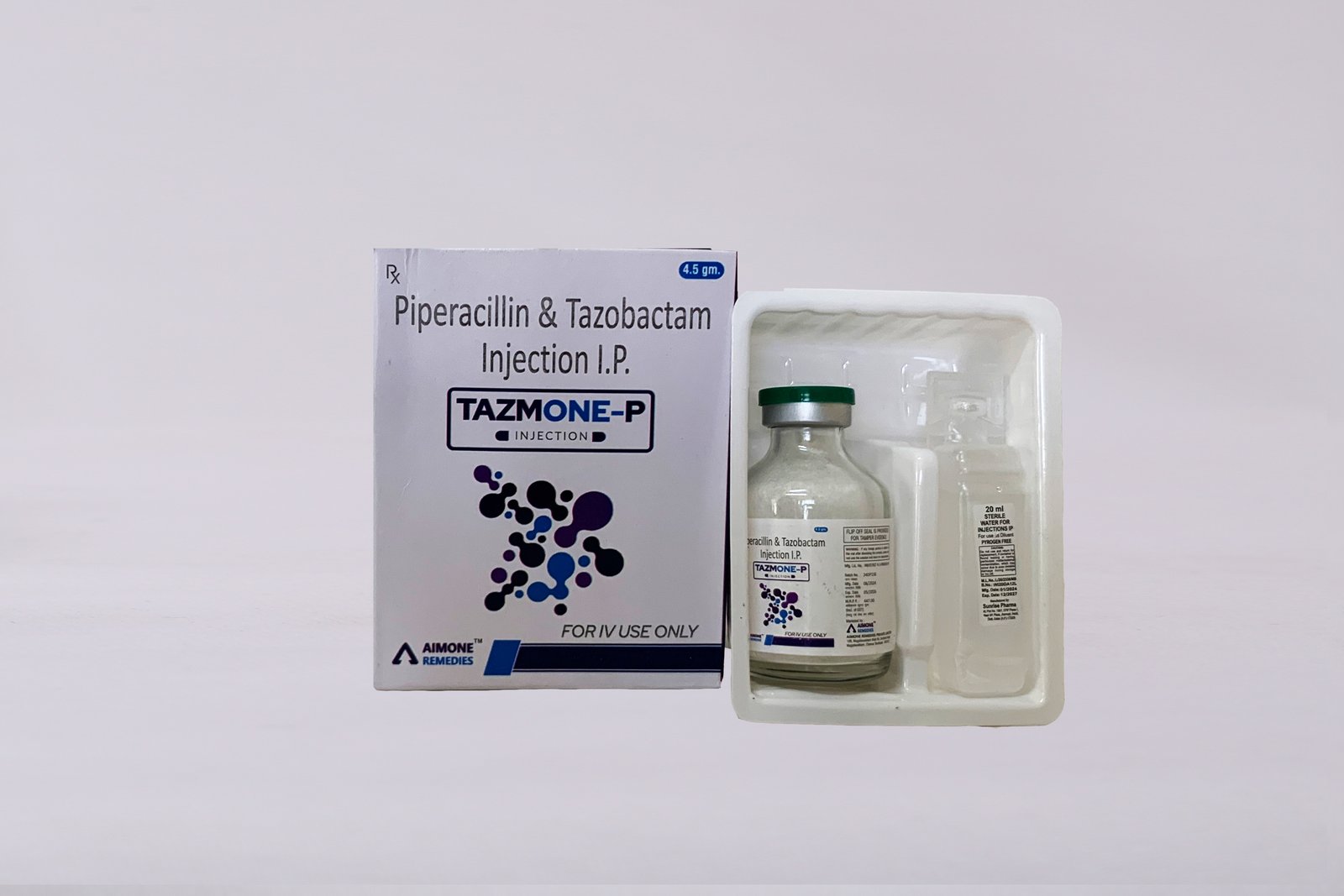
TAZMONE P
Piperacillin-Tazobactam Injection
Piperacillin-Tazobactam Injection is a combination antibiotic used to treat a wide variety of bacterial infections. It combines Piperacillin, a broad-spectrum penicillin antibiotic, with Tazobactam, a beta-lactamase inhibitor. This combination helps to overcome bacterial resistance to certain beta-lactam antibiotics.

Components and Mechanism of Action
Piperacillin:
A penicillin-class antibiotic that works by inhibiting the bacterial cell wall synthesis. By disrupting the formation of the bacterial cell wall, it causes the bacteria to rupture and dieSpectrum of Activity: Piperacillin is effective against gram-positive, gram-negative, and anaerobic bacteria. It is particularly active against Pseudomonas aeruginosa and other difficult-to-treat organisms
Tazobactam:
A beta-lactamase inhibitor that works by inhibiting beta-lactamase enzymes produced by certain bacteria to break down beta-lactam antibiotics (like Piperacillin). This allows Piperacillin to remain effective against bacteria that would otherwise be resistant.
Indications
Piperacillin-Tazobactam is used for the treatment of a wide range of infections caused by susceptible organisms. These include:
Respiratory Tract Infections:
Such as pneumonia (community-acquired and hospital-acquired), bronchitis, and other lower respiratory tract infections.Urinary Tract Infections (UTIs):
Including pyelonephritis and complicated UTIs.Intra-abdominal Infections:
Such as peritonitis, appendicitis, and abdominal abscesses.Skin and Soft Tissue Infections:
Including cellulitis and wound infections.Bone and Joint Infections:
Such as osteomyelitis.Bloodstream Infections (Sepsis): Particularly those caused by multi-drug-resistant organisms.
Gynecological Infections:
Including endometritis and pelvic inflammatory disease.Complicated Infections in Immunocompromised Patients:
For patients with weakened immune systems, such as those undergoing chemotherapy or with neutropenia.
Dosage and Administration
Adults:
The typical dosage for Piperacillin-Tazobactam for adults is 3.375 to 4.5 grams intravenously (IV) every 6 to 8 hours, depending on the severity of the infection. For more severe infections, higher doses may be required.Children:
Pediatric dosing is based on body weight and the severity of the infection, typically ranging from 100 mg to 200 mg per kg of body weight per day, divided into doses.Administration:
Piperacillin-Tazobactam is typically administered intravenously (IV) or intramuscularly (IM). The IV form is preferred for severe infections.Duration:
The duration of treatment typically lasts from 5 to 14 days, depending on the type of infection and its severity.- Gastrointestinal symptoms: Nausea, vomiting, diarrhea, or abdominal pain.
- Allergic reactions: Rash, itching, or swelling. Severe allergic reactions (anaphylaxis) can occur, though rarely.
- Injection site reactions: Pain, redness, or swelling at the injection site.
- Hematologic reactions: Temporary changes in blood counts, such as low white blood cell counts (leukopenia) or low platelet counts (thrombocytopenia).
- Liver enzyme elevations: Mild increases in liver enzymes may occur, which are usually reversible after discontinuation.
- Kidney function: Elevated creatinine or blood urea nitrogen (BUN) levels may indicate kidney dysfunction.
- Hypersensitivity: Caution is advised in patients with a history of allergies to penicillins or cephalosporins, as there is a risk of cross-reactivity. If an allergic reaction occurs, the drug should be discontinued immediately.
- Renal Impairment: Dose adjustments may be necessary for patients with kidney dysfunction, as Piperacillin-Tazobactam is excreted through the kidneys.
- Pregnancy and Breastfeeding: Piperacillin-Tazobactam is generally considered safe during pregnancy (Category B), but it should be used only when necessary. It is excreted into breast milk in small amounts, so consult a healthcare provider if breastfeeding.
- Superinfection: Long-term use may result in the overgrowth of non-susceptible organisms, including fungi, leading to secondary infections.
Side Effects
Common side effects include:
